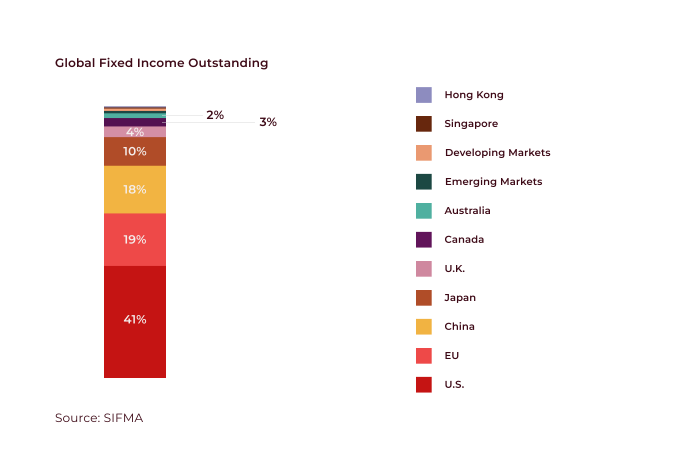In 2022 the global bond market totaled USD 122.6 trillion. The global high-yield bond market exceeded USD 4.5 trillion. Whereas a decade ago, high-yield bond markets consisted primarily of US issuers, today the market has internationalized with many issuers coming from European and emerging economies. The European high-yield bond market, still less mature than its US counterpart, has more than quadrupled in size since 2008. The emerging economies high-yield corporate segment has experienced tremendous growth and today stands at approx USD 1 trillion, with substantial scope for further growth. Companies in emerging economies primarily use the corporate bond market to refinance existing loans at more favourable terms. Balance sheets of emerging markets corporates frequently show lower leverage than their corporate comparables in development economies, with lower leverage and higher cash-to-debt ratios, while providing more credit spread for equivalent leverage.
The global credit market (bonds and bank loans) in aggregate is about three times the size of the global equity market. This growth has been fuelled by government and corporate debt sales across major developed and emerging economies.

In terms of country of incorporation, global bond markets are dominated by the United States with USD 51 trillion in total debt outstanding (Q3/2023), of which USD 11.3 trillion in US corporate bonds, and China as the third largest corporate bond market with USD 7.4 trillion, jointly 49 per cent of the total global corporate bond market, of which 53 per cent, or USD 21.5 trillion, are issued by financial institutions. China’s onshore bond market has been estimated at USD 17.2 trillion, of which approx. USD 6.95 trillion in onshore corporate bonds. Available data suggest that China holds about 50 per cent of its reserves in dollar bonds, of which USD 869bn in US debt.

Challenges persist, and the doors to global capital markets have remained shut for the majority of emerging markets governments and corporates in 2023. Many Sub-Saharan African countries, one of the more volatile markets, have found itself trapped by high interest rates, foreign exchange volatility, and persistent inflation. Market liquidity can be particularly challenging in emerging markets credit markets. Although sovereign Eurobonds offer flexibility compared to traditional conditional loans, they come with higher costs, high yields (from 5%-18%), and shorter maturities. Nigeria, Kenya, Angola, Egypt, and Ghana are allocating substantial portions of their tax revenues to interest repayments, with Nigeria consuming over 80 per cent of federal revenue for debt repayments, a trend the IMF expects to reach nearly 100 per cent in 2026. Ghana’s debt-to-revenue service ranged between 70 and 100 percent in 2023.
Africa remains an attractive place for investors seeking higher yields compared to other emerging economies. Yields on sovereign bonds in Sub-Saharan Africa are, for example, 3 per cent+ higher than in Saudi Arabia. Trade is focused on the “spread”, the yield difference between these bonds and US Treasury bonds, with a higher spread indicating higher risks with possible higher returns. Several bonds have been oversubscribed, even in times of default, when a bond is trading higher or lower than anticipated, eg in the case of Ghana’s sovereign bonds, trading in the low 40s to USD. Post-restructuring these bonds might trade at 50, which will attract investors.

